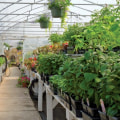Horticulture is divided into the cultivation of plants for food (pomology and olericulture) and plants for ornament (floriculture and landscape horticulture). Pomology deals with fruit and nut crops. Olericulture deals with herbaceous plants for cooking, including, for example, carrots (edible root), asparagus (edible stem), lettuce (edible leaf), cauliflower (edible buds), tomatoes (edible fruit) and peas (edible seeds).
Floriculture
deals with the production of flowers and plants ornamental, usually cut flowers, potted plants, and vegetation.Landscape horticulture is a broad category that includes landscape plants, including lawns, but particularly nursery crops such as shrubs, trees and vines. Horticulture is the field of study that focuses on gardening, and the plants and biological systems that make up a garden. Horticulture is a broad science that has many subdisciplines. Horticulture studies both the science behind the garden and aesthetics, which makes it attractive to the eye.
For example, floriculture focuses on flower production, while viticulture studies grapes exclusively. Horticulturists can find themselves in a variety of positions, from maintaining community gardens to conserving plants in a museum. Horticulture also overlaps with several other sciences, which are discussed below. Horticulture is a branch or field of botany that deals with edible and ornamental plants.
Horticulturists do not research, but rather use or “apply” scientific research carried out by botanists. Horticulture is the art of growing plants in gardens to produce food and medicinal ingredients, or for comfort and ornamental purposes. Horticulturists are farmers who grow flowers, fruits and nuts, vegetables and herbs, as well as ornamental trees and lawns. The Bureau of Labor Statistics does not divide horticulturists and botanists as separate fields when looking at the Bureau of Labor Statistics.
Due to the practical nature of the field, many later horticulture classes will take you to gardens and farms to experience the work. The Ancient Society of York Florists is the oldest horticultural society in the world and was founded in 1768; this organization continues to organize four horticultural exhibitions a year in York, United Kingdom. Horticulture provides mankind with new varieties and gardening methods, which can then be implemented on a larger scale. Instead of completing a formal education, they can gain work experience in related areas, such as landscaping or gardening, before moving to horticulture.
Temperate zones for horticulture cannot be defined exactly by lines of latitude or longitude, but are generally considered to include those areas where frost occurs in winter, albeit rarely. In terms of scale, horticulture lies between home gardening and field farming, although all forms of cultivation naturally have close links. Horticulture gives man the tools to combat nature and guide the garden to be productive and fruitful. Horticulture is the science and art of the development, sustainable production, marketing and use of intensively cultivated, high-value ornamental and food plants.
Botanists and horticulturists can increase their earning potential by gaining professional experience or expanding their education, such as specializing in a specific area. The word horticulture is based on the model of agriculture; it derives from the Latin words hortus and culture, which mean “garden” and “cultivation”, respectively.






